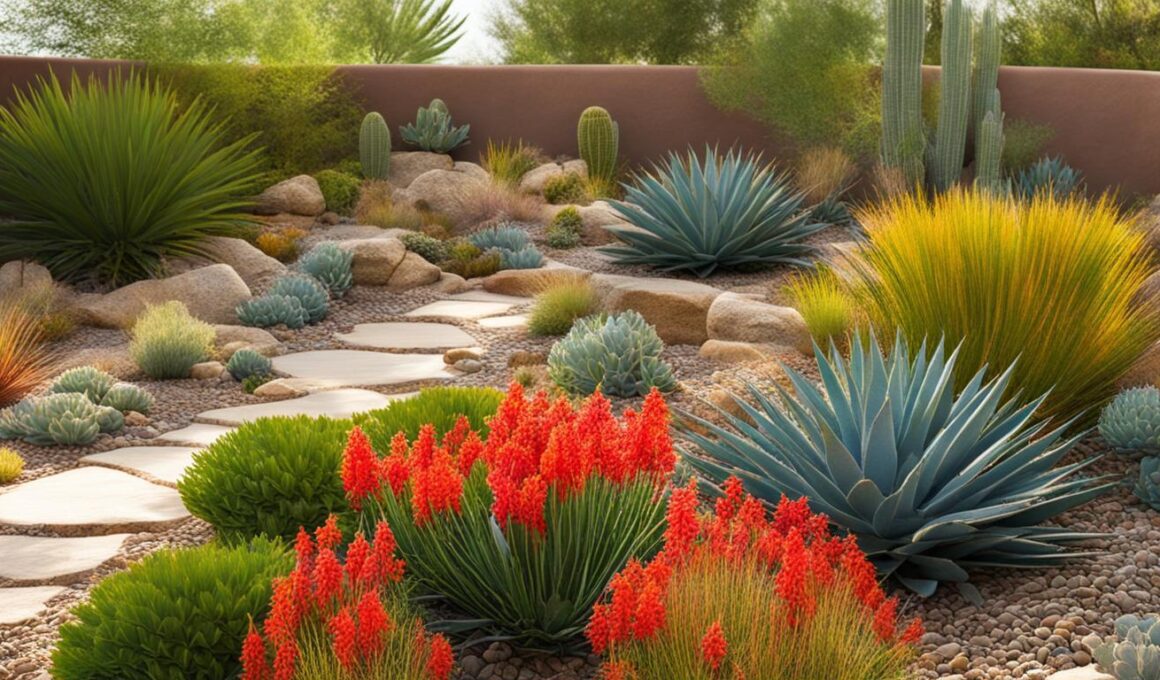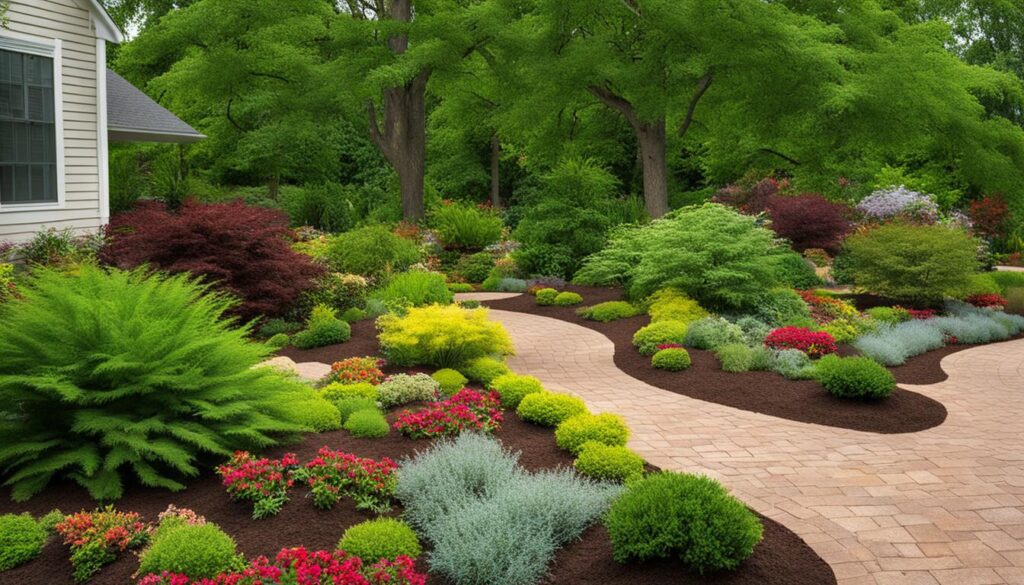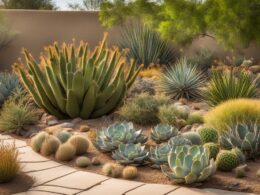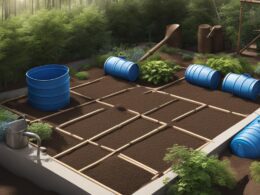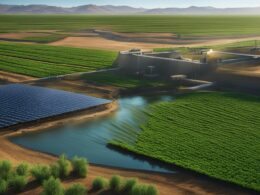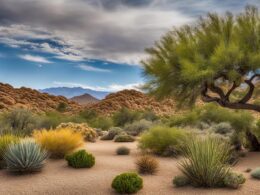Welcome to the world of climate-adaptive xeriscape color schemes! If you’re looking to create a sustainable garden that thrives in your local environment while conserving water, then you’ve come to the right place. With the right design and plant choices, you can transform your outdoor space into a vibrant and visually appealing oasis that is both environmentally friendly and low-maintenance.
By implementing climate-adaptive xeriscape color schemes, you can achieve a water-wise landscape design that not only reduces your water consumption but also enhances the beauty of your garden. Whether you live in a dry desert climate or a more temperate region, there are color schemes and plant combinations that will suit your unique environment.
In this article, we will explore various aspects of climate-adaptive xeriscape design, including the benefits of mulch, the use of native plants, and incorporating drought-tolerant perennials and annuals. These key elements will help you create a sustainable garden that brings color, texture, and life to your outdoor space.
So, get ready to embark on a journey of creating a sustainable garden that adapts to your climate. Let’s explore the world of climate-adaptive xeriscape color schemes and discover the endless possibilities for your outdoor oasis!
Key Takeaways:
- Climate-adaptive xeriscape color schemes offer a sustainable and water-wise approach to landscaping.
- By using mulch, native plants, and drought-tolerant perennials and annuals, you can create a vibrant and low-maintenance garden.
- Xeriscape gardens conserve water and thrive in different climates.
- With careful design and plant selection, you can transform your outdoor space into an environmentally friendly and visually appealing oasis.
- Start planning your climate-adaptive xeriscape design today and enjoy a sustainable and colorful garden.
The Benefits of Mulch in Xeriscape Design
When it comes to creating a sustainable and water-wise xeriscape garden, one element that shouldn’t be overlooked is mulch. Xeriscape mulch offers numerous benefits that contribute to water conservation, soil protection, and erosion control.
First and foremost, mulch acts as a natural barrier against weed growth. By covering the soil surface with a layer of mulch, it prevents weed seeds from receiving the sunlight they need to sprout and thrive. This reduces the need for manual weed removal or the use of chemical herbicides, making your xeriscape garden more environmentally friendly.
Another advantage of mulch in xeriscape design is its ability to reduce soil evaporation. By acting as a protective layer, mulch helps to retain moisture in the soil, minimizing water loss through evaporation. This is especially important in regions with hot and arid climates, where water conservation is crucial for maintaining a healthy garden.
Mulch also plays a role in protecting the soil and plants from extreme temperatures. It acts as insulation, keeping the soil cooler in hot weather and warmer in cold weather. This temperature regulation not only benefits the plants but also promotes healthy soil biology, creating a favorable environment for beneficial organisms that contribute to the overall health of your xeriscape garden.
With a wide variety of textures, colors, and materials available, mulch also offers aesthetic benefits. You can choose mulch that complements your xeriscape color schemes, creating visual interest and focal points throughout your garden. Whether you opt for organic mulch like wood chips or inorganic options like gravel or pebbles, incorporating mulch into your xeriscape design allows for an attractive and sustainable outdoor space.
Key benefits of mulch in xeriscape design:
- Suppresses weed growth, reducing the need for herbicides
- Conserves water by reducing soil evaporation
- Protects the soil and plants from extreme temperatures
- Enhances aesthetic appeal with various textures and colors
“Mulch is a game-changer in xeriscape design. From conserving water to providing soil protection, it offers a multitude of benefits that contribute to the overall sustainability and beauty of your garden.”
By incorporating mulch into your xeriscape design, you can create a more resilient and environmentally friendly outdoor space. From weed suppression to water conservation and soil protection, mulch is an essential component of a successful xeriscape garden.
Native Plants for Water-Wise Xeriscaping
When it comes to creating a water-wise xeriscape garden, incorporating native plants is essential. Native plants are well-adapted to the local climate and require minimal water beyond natural rainfall. By choosing these plants, you can significantly reduce your water consumption while still enjoying a beautiful and vibrant garden.
Native plants are naturally drought-tolerant, meaning they have evolved to survive in the local environment with limited water resources. They have deep root systems that allow them to access water from deeper soil layers and are more resistant to drought conditions. This makes them an excellent choice for xeriscaping, as they can thrive without the need for frequent watering.
“Using native plants in xeriscaping not only conserves water but also supports the local ecosystem. These plants provide food and shelter for native wildlife, including birds, butterflies, and bees. By incorporating them into your garden, you are creating a sustainable habitat that encourages biodiversity.”
Another advantage of native plants is their low-maintenance nature. Since they are well-suited to the local climate and soil conditions, they require minimal care once established. They are more resistant to local diseases and pests, reducing the need for chemical pesticides or fertilizers. This not only helps to create a healthier environment but also saves time and effort in garden maintenance.
To enhance the water conservation efforts in your xeriscape garden, consider incorporating native plants such as purple coneflower (Echinacea), black-eyed Susan (Rudbeckia), and prairie sage (Artemisia). These plants not only provide beautiful blooms and foliage but also support a sustainable and eco-friendly garden.
Benefits of Native Plants in Xeriscaping:
- Reduced water consumption
- Drought-tolerance
- Support for local ecosystem and biodiversity
- Low-maintenance
- Natural resistance to local diseases and pests
Can I Use the Color Schemes in Xeriscape Garden Designs to Adapt to my Climate?
Yes, you can use the color schemes in stunning xeriscape garden designs to adapt to your climate. By selecting drought-tolerant plants with vibrant colors that thrive in your specific climate, you can create a visually appealing and sustainable xeriscape garden that suits your local environment.
Perennials and Annuals for Colorful Xeriscape Designs
When it comes to creating vibrant and visually appealing xeriscape gardens, incorporating a combination of drought-tolerant perennials and vibrant annuals is key. These plant varieties not only add color and texture to your garden but also thrive with low water usage. By strategically selecting perennials and annuals, you can create stunning garden color schemes that make a statement.
Drought-tolerant perennials are the backbone of a successful xeriscape garden. These hardy plants can withstand dry conditions and require minimal irrigation once established. Consider incorporating perennials such as lavender, yarrow, and ornamental grasses. These plants not only add beauty to your garden but also attract pollinators and provide habitat for beneficial insects.
On the other hand, annuals offer the opportunity to experiment with different colors and design ideas every planting season. You can choose vibrant annuals like marigolds, zinnias, and petunias to create bursts of color and contrast in your xeriscape design. Annuals can be planted in containers, hanging baskets, or garden beds, allowing you to showcase their beauty in various ways throughout your garden.
Creating Harmonious Garden Color Schemes
When selecting perennials and annuals for your xeriscape garden, keep in mind the importance of creating harmonious color schemes. Choose plants that complement each other in terms of color and bloom time. You can opt for a monochromatic color scheme, using different shades of a single color, or create a vibrant and contrasting color palette by combining plants with complementary hues.
Remember to consider the overall aesthetic of your garden and the surrounding environment when choosing your perennials and annuals. Aim for a balanced and cohesive design that enhances the beauty of your space.
By integrating both drought-tolerant perennials and vibrant annuals into your xeriscape design, you can achieve a dynamic and visually appealing garden that requires minimal water usage. These plants not only add color and texture but also contribute to the overall sustainability of your landscape.
Conclusion
Xeriscape design offers a sustainable and water-wise approach to landscaping, creating a harmonious balance between beauty and environmental responsibility. By incorporating mulch, native plants, drought-tolerant perennials, and annuals, you can design a vibrant and low-maintenance garden that conserves water and thrives in your local climate.
Mulch plays a crucial role in xeriscape design. It not only suppresses weed growth and reduces erosion but also protects the soil and plants from extreme temperatures. By adding mulch to your garden, you can conserve water by reducing evaporation and add essential nutrients to the soil. The wide range of textures, colors, and materials available for mulch allows you to create visual interest and focal points in your landscape.
Native plants are another key element of climate-adaptive xeriscape. These plants are well-suited to the local climate and require minimal additional watering beyond natural rainfall. Their natural resistance to local diseases and pests also makes them low-maintenance options. By selecting drought-tolerant native plants, you can enhance water conservation in your xeriscape garden while creating a beautiful and sustainable landscape.
Combining drought-tolerant perennials and vibrant annuals brings color and texture to your xeriscape garden. Drought-tolerant perennials reseed for multiple seasons and require minimal irrigation once established. Perennial grasses and salvias are excellent choices for creating vibrant and low-maintenance gardens. On the other hand, annuals offer the opportunity to change color schemes and design ideas every planting season. By incorporating both perennials and annuals, you can create a dynamic and visually appealing xeriscape garden.
Start planning your climate-adaptive xeriscape design today and enjoy a sustainable and colorful garden that not only enhances the beauty of your outdoor space but also supports the health of our planet. By implementing these strategies, you can create a landscape that is both environmentally friendly and visually stunning. Embrace the principles of xeriscape design, and let your garden become a haven of sustainable landscaping.





